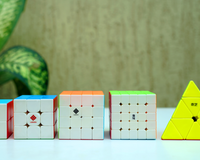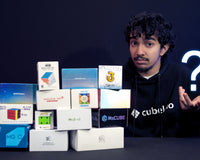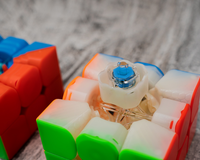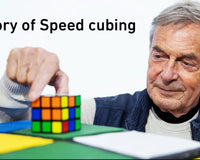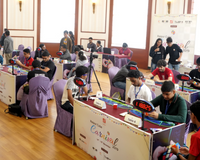Introduction
When buying a speedcube, corner cutting is one of the most important features to look out for. A cube with bad corner cutting is not very fit for speedcubing and a cube with good corner cutting may or may not be fit for speedcubing! I know all of this sounds confusing so let me clear it all up in this blog!
What is Corner-Cutting?
Let us take two adjacent sides of a cube. Corner cutting is the amount in degrees that one side of the cube is turned at, such that turning the other adjacent side is still possible. Let the two adjacent sides be the R (Right) and U (Upper) layers for example, and let’s say that the U layer is moved by 35 degrees. Now if we perform an R move and the U layer goes back to its original position, then the cube corner cuts at 35 degrees. This is valid for all angles. For example, if the U layer is moved by 45 degrees and we perform an R move and the U layer goes back to its original position, then the cube corner cuts at 45 degrees. Some cubes don’t have much flexibility with corner cutting and moving the R side might not even be possible if the U layer is turned by 35 or 45 degrees. In that case, the cube tends to lock up.
If all of this still doesn’t make sense to you, here’s a GIF!

Why is Corner Cutting Important?
In older Rubik’s cubes, corner cutting never used to be a thing. Corner cutting became important when speedcubing became popular. The race to solve as fast as possible also depended on the hardware, so manufacturers tried new designs and new models, to get the best performance while speedsolving. One of these factors was obviously, corner cutting.
We are human beings, and it’s impossible to be so accurate while turning fast that you complete every turn fully and don’t overshoot. So there must be a margin of error. This is corner-cutting explained differently. It is a margin of error while doing one turn such that the next turn can be completed without any issues.
If there was no corner cutting and the cube models would be such that a turn would only be possible if the previous turn was completed correctly, it would make speedsolving difficult because the cube would lock up all the time and would feel tight and you’d have to be really accurate to even try speedsolving.
So basically, corner cutting makes your solving more efficient and smooth while avoiding time-wasting lockups or pops!
Forward and Reverse Corner Cutting
To understand both these terms, we need an example. Let us take our previous example with the two adjacent sides being the R and U face. Consider your cube is in a solid solved state. Let’s continue
- Forward corner cutting is when you turn the U layer clockwise and attempt to make an (R) move. Obviously, after a certain angle, this is not possible. The highest angle at which this corner cutting is possible is considered to be an important feature of a cube. Guess what this feature is called, “FORWARD CORNER CUTTING”!
- Reverse corner cutting is when you turn the U layer clockwise and attempt to make an (R’) move. If you apply this, you can clearly see that during the process, the R layer encounters the centerpiece of the F layer. Due to this, the highest angle at which reverse corner cutting is possible is always lower than that of forward corner cutting.

How to have better Corner Cutting in your Cubes?
There are many reasons why your puzzle might not be corner-cutting well. The two main reasons are the cube hardware and the tension setting.
- If you have a really old outdated cube, it’s recommended to just buy a new one. Speedcubes these days are really cheap and you can buy a good magnetic speedcube at Cubelelo for under 600 INR!
- If you already have a good speedcube, chances are that your tension settings are too tight. Try loosening the tension a bit, and make sure all sides have the same tension settings. If loosening the tensions even a little bit makes your cube unstable, then I would recommend just buying a new puzzle.

What puzzle has the best corner cutting?
Modern puzzles nowadays have exceptional corner cutting and almost every puzzle can cut past 45 degrees. Even budget puzzles have good corner-cutting! Corner-cutting isn’t the only factor determining a cube’s performance, so there’s no best puzzle here! If you want a new puzzle, I’d recommend checking out our puzzle-buying guide for 2023.
Keep cubing!
About Author

Sarthak Masta
Sarthak Masta is a speedcuber from Raipur. He started cubing in 2013 and now has 9 years of cubing experience. Apart from cubing, Sarthak enjoys making music and singing. He has attended a total of 7 competitions in Raipur and has gotten 10 podiums, with 2 gold medals, 4 silver medals and 4 bronze medals.

















